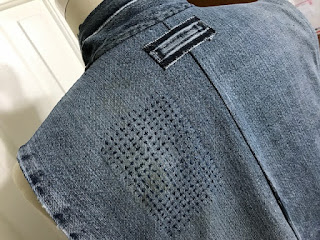 |
| Black walnuts |
 |
| Rough-cutting some cotton sateen and folding it in preparation for black walnut dips. Lining for a coat. |
Black walnut dyeing has become an annual treat for me. Part of the fun is finding the walnuts near my home. They can easily blend in with their surroundings and I'm only beginning to recognize the trees.
If you look closely, you'll see them dangeling from the way-high-up branches. The recent winds and rain from Florida huricanes have caused many of them to drop. It's such fun to suddenly see them.
Pokeberry is instant gratification.
When I don't find the walnuts, I find pokeberries and goldenrod and lichen. I steamed these on a piece of cotton sateen.
I am learning that slow dyeing may have better results. Many things are like that, aren't they? I am soaking my walnuts and then, very gently, simmering them. I haven't tried to save the actual nuts and feel just a tiny bit guilty about it. The color has me transfixed.
Admittedly I did drop this folded piece in with the soaking and then simmering walnuts. This first piece is satisfying. I also dip-dyed some paper and got quick results - a kind of moonscape.
Here is the steamed pokeberry-goldenrod-lichen piece. Slow stitching is next.
Not every piece is rich is saturated color.
 |
| eco-print attempt with leaves from the back yard |
And steeping.
And waiting.
















































